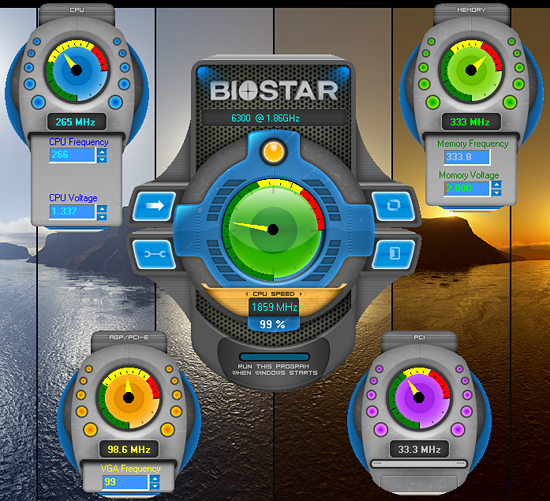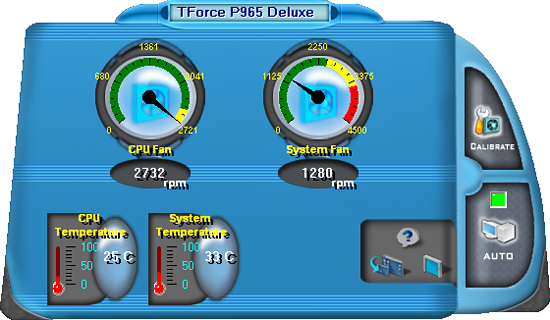Intel P965: Mid-Range Performance Sector Roundup
by Gary Key on October 20, 2006 9:00 PM EST- Posted in
- Motherboards
Biostar TForce P965 Deluxe: Feature Set
We really liked the Biostar TForce P965 Deluxe motherboard when we reviewed it in our Conroe Buying Guide as we thought it had the best blend of performance and price at the time. One omission in this motherboard is the lack of Firewire support that we found in both the Asus and Abit boards. Considering this motherboard is in the $150 price range we find this to be perplexing. Also, the memory voltage only goes to 2.2V but this did not hinder its overclocking capabilities during testing.
The only real change in the motherboard since its release has been a significant upgrade to the BIOS that cleared any remaining memory compatibility issues along with an increase in overclocking capability to 500FSB. The motherboard is the only one in our roundup to use the VIA VT6410 IDE chipset instead of the now standard JMicron JMB363. While it does not offer additional SATA ports like the JMicron, the IDE performance and compatibility was better in our testing. Our original feelings about the performance and compatibility of this board have not changed but we have noticed the board to be in very short supply. Biostar assures us this supply issue will be solved by early November.


Biostar includes several software utilities with the board: an Overclock Program, Hardware Monitoring application, Smart Fan Utility, and an online BIOS update applet. The overclock utility allows for changes to the FSB and basic system voltages. The smart fan utility allows control of the CPU and main system fan header within Windows. The Hardware monitoring utility allows for real time monitoring of CPU temperature, CPU fan speeds, and basic system voltages. Biostar includes an automatic overclocking utility in their BIOS that offers three different settings named V6, V8, and V12.
We naturally selected the V12 setting in the BIOS and after a reboot were greeted with Ford Pinto performance. Okay, it was not that bad but the final results were a blistering 2009MHz CPU speed via a 7x287FSB with the memory speed at DDR2-715. However, the system was smart enough unlike our other boards to actually set the memory timings at something other than an ultra safe 5-5-5-15 setting with actual timings at 4-4-4-10. This is unusual as the BIOS will default to DDR2-667 (4:5) settings with timings at 5-5-5-15 when left on auto settings. Overall, the automatic overclocking worked without any issues and provided a small increase in speed just as Biostar intended it to work.
| Biostar TForce 965 Deluxe | |
| Market Segment: | Mid-Range Performance |
| CPU Interface: | Socket T (Socket 775) |
| CPU Support: | LGA775-based Pentium 4, Celeron D, Pentium D, Pentium EE, Core 2 Duo, Core 2 Extreme |
| Chipset: | Intel P965 + ICH8R |
| Bus Speeds: | 200 to 500 in 1MHz Increments |
| Memory Speeds: | Auto, 533, 667, 800 |
| PCIe Speeds: | Auto, CPU, Fixed at 100MHz, 100MHz~200MHz |
| PCI: | Fixed at 33.33MHz |
| Core Voltage: | Startup, 1.10000V to 1.80000V in 0.00625V increments |
| CPU Clock Multiplier: | Auto, 6x-11x in 1X increments for Core 2 Duo |
| DRAM Voltage: | 1.8V, 2.0V, 2.1V, 2.2V |
| DRAM Timing Control: | SPD, 8 DRAM Timing Options |
| NB Voltage: | Auto,1.5V, 1.6V, 1.7V, 1.8V |
| Memory Slots: | Four 240-pin DDR2 DIMM Slots Dual-Channel Configuration Regular Unbuffered Memory to 8GB Total |
| Expansion Slots: | 1 - PCIe X16 1 - PCIe X4 1 - PCIe X1 3 - PCI Slot 2.3 |
| Onboard SATA/RAID: | 6 SATA 3Gbps Ports - Intel ICH8R (RAID 0,1,5, 1+0,JBOD) |
| Onboard IDE: | 1 Standard ATA133/100/66/33 Port (2 drives) - VIA VT6410 |
| Onboard USB 2.0/IEEE-1394: | 10 USB 2.0 Ports - 4 I/O Panel - 6 via Headers No Firewire Support |
| Onboard LAN: | Gigabit Ethernet Controller - PCI Express Interface Realtek RTL 8110SC |
| Onboard Audio: | Realtek ALC883 HD-Audio 8-channel CODEC |
| Power Connectors: | ATX 24-pin, 4-pin EATX 12V |
| I/O Panel: | 1 x PS/2 Keyboard 1 x PS/2 Mouse 1 x Serial 1 x Audio Panel 1 x RJ45 6 x USB 2.0/1.1 |
| BIOS Revision: | AWARD ip96a803 |
We really liked the Biostar TForce P965 Deluxe motherboard when we reviewed it in our Conroe Buying Guide as we thought it had the best blend of performance and price at the time. One omission in this motherboard is the lack of Firewire support that we found in both the Asus and Abit boards. Considering this motherboard is in the $150 price range we find this to be perplexing. Also, the memory voltage only goes to 2.2V but this did not hinder its overclocking capabilities during testing.
The only real change in the motherboard since its release has been a significant upgrade to the BIOS that cleared any remaining memory compatibility issues along with an increase in overclocking capability to 500FSB. The motherboard is the only one in our roundup to use the VIA VT6410 IDE chipset instead of the now standard JMicron JMB363. While it does not offer additional SATA ports like the JMicron, the IDE performance and compatibility was better in our testing. Our original feelings about the performance and compatibility of this board have not changed but we have noticed the board to be in very short supply. Biostar assures us this supply issue will be solved by early November.


Biostar includes several software utilities with the board: an Overclock Program, Hardware Monitoring application, Smart Fan Utility, and an online BIOS update applet. The overclock utility allows for changes to the FSB and basic system voltages. The smart fan utility allows control of the CPU and main system fan header within Windows. The Hardware monitoring utility allows for real time monitoring of CPU temperature, CPU fan speeds, and basic system voltages. Biostar includes an automatic overclocking utility in their BIOS that offers three different settings named V6, V8, and V12.
We naturally selected the V12 setting in the BIOS and after a reboot were greeted with Ford Pinto performance. Okay, it was not that bad but the final results were a blistering 2009MHz CPU speed via a 7x287FSB with the memory speed at DDR2-715. However, the system was smart enough unlike our other boards to actually set the memory timings at something other than an ultra safe 5-5-5-15 setting with actual timings at 4-4-4-10. This is unusual as the BIOS will default to DDR2-667 (4:5) settings with timings at 5-5-5-15 when left on auto settings. Overall, the automatic overclocking worked without any issues and provided a small increase in speed just as Biostar intended it to work.










62 Comments
View All Comments
Gary Key - Saturday, October 21, 2006 - link
The DS4 will be reviewed. Gigabyte has stated they will not bring it into the US but we are still trying to convince them (really more like begging and calling our marketing rep at home on the weekends to beg some more) to release it in the States. The copper backplate can be removed off the DQ6 and I really did not see any benefit with it on in testing. It makes for a good rebate with the price of copper today. ;-)The AHCI issues stay the way they are at this time. It is frustrating to say the least. I was being a bit sarcastic in my statement but it is a little harder than it should be to enable AHCI on the ICH8R.
Ryan Norton - Sunday, October 22, 2006 - link
I'm in Taiwan, so the DS4 is all over the place :)Capt Caveman - Saturday, October 21, 2006 - link
Not sure if you live in the US or not but Gigabyte is not bringing/selling the DS4 to the US.Also, the copper backplate for the DQ-6, can be removed with a tworx(sp?) screwdriver. At XS, many just went to Home Depot and got longer screws for their HSF.
lopri - Saturday, October 21, 2006 - link
Excellent review that'll help potential buyers enormously. A couple things:1. Error in the chart (page 14): There is a discrepency between the chart (3-4-3) and the commentary (3-4-4) :)
2. In memory review Wesley always put tRP ahead of tRCD, while Gary does the opposite. It'd be nice to have a consistency for less experienced users!
3. Gary, did you test the P5W-DH with wirless module installed or without? I recently found out the wirless module could skew CPU/memory-sensitive benchmarks on this board big time. I'm not sure if my finding is true in general, but if it is, then the comparison between a board with such feature and a board without it can be unfair.
4. Can Sandra Unbuffered be really an indication of general performace? @400FSB, setting memory ratio 4:5 (DDR2-1000/4-4-3) boosted the score by a whooping 400~500 MB/s from the ratio 1:1 (DDR2-800/3-3-3), which never realized for other tests in a meaningful way. Oh this is about my own testing. :D
Thanks for the great review.
Gary Key - Saturday, October 21, 2006 - link
Thanks for the comments.1. The timing error is corrected. Jarred and I were editing at the same and we found out after the article went live that our saves to the final copy would overwrite each other. Bad timing for several other mistakes that have been cleared up now.
2. Wes is wrong. Just kidding, we will get on the same page. :)
3. I turned off the WiFi on the PSW-DH. The scores were even worse with it on. Not that they are bad but the board runs a little looser timings in order to overclock at the high end. DFI also does this with their boards targeted for the overclocking market.
4. Sandra Unbuffered can be an indication of performance in apps that are memory sensitive. This is not always the case but it is one of the better yardsticks available at this time.
Lothar - Saturday, October 21, 2006 - link
Do you plan on comparing the Gigabyte DS3 vs the S3 version for us to know if there are performance/overclocking issues with the S3?The only difference so far between the DS3 and S3 is "All Solid Capacitors".
Are there any other difference I'm missing?
The S3 is $110, and the DS3 is $150.
I have a hard time to justify paying an extra $40 for only "all solid capacitors"
The term is nothing but marketing to me so far.
I haven't seen any proof of a performance/overclocking issue between the two boards.
If you or anyone else plan on testing the differences or can provide something(Ex: any review link) stating otherwise, that would be great.
Nakazato - Monday, October 23, 2006 - link
In theory, cleaner power.... but aside from the theory, the onboard sound does start flaking out the higher you go. This has been true on 2/2 boards I've tried it on. So an add-in card is needed for the higher overclocks... 460+ish.goinginstyle - Monday, October 23, 2006 - link
No issue here with the Biostar board at 500FSB and the Realtek ALC-883. It sounds fine but a X-FI is still the way to go for gaming.Gary Key - Saturday, October 21, 2006 - link
Yes, the S3 will be in part two. :)
Lothar - Saturday, October 21, 2006 - link
The only other differences I found were RAID support and 2 extra USB ports...It's not worth the $40 price difference if performance and overclocking results are the same IMO.